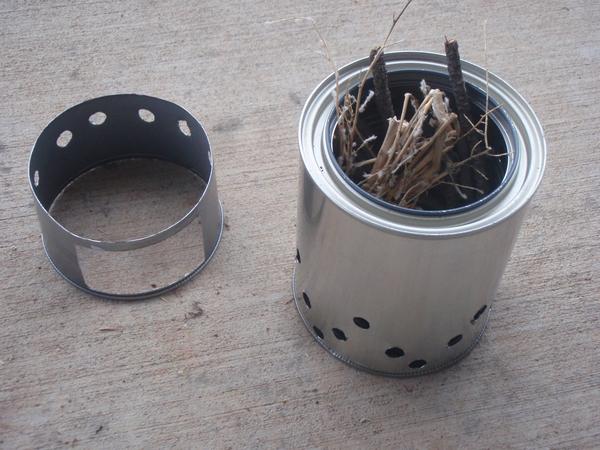I’m a latecomer when it comes to wood gas stoves, but after building my own version over the 2010 Christmas break, I’ve recently turned into a fan. My first exposure to wood-burning backpacking stoves was a Sierra stove that another adult leader brought to a Boy Scout training event. At the time, I thought they were too much hassle, a bit messy, and (in the case of the Sierra) required batteries and electronics that I worried would be difficult to repair in the field.
After so many posts on HF, I decided to look into wood stoves and with sclittlefield‘s photos and instructions, I went out to build my own (I couldn’t afford any of the commercial variants at the time).
There are a few ways to build a wood-gas stove, but this is how I did it. When I looked at other designs, the tool list included some peculiar tools that I would never really use much like large hole punches and strange lid removers. I decided that if this were to be a true DIY project, I would have to use what I had on hand. Here’s how I built it:
SUPPLIES
- 1 – 13 oz can (“Member’s Mark” Chicken Chunks from Sam’s Club”)
- 1 – 1 qt empty paint can (from Home Depot, lid not required)
- 1 – 19 oz can (Progresso Soup, or a 20 oz Pineapple Chunks can)
- 1 – wire mesh (some suggest 3×3 wire mesh, but Home Depot only sold big rolls, which was too much and more money than I wanted to spend. The best alternative I found was a 2 ft long piece of gutter screen for $2—plenty of wire screen for my project and not expensive)
TOOLS
- Kitchen can opener
- Drill with big drill bit (or a 1 in metal hole punch)
- Dremel with circular metal cutting bit
- Large metal shears (for cutting the wire mesh)
One fun part was eating the food. A lot easier than disposing of the cat food when building my cat can alcohol stove.
The Progresso Soup can had an easy-open-top, so the only can I needed a can opener was for the chicken chunks. A regular can opener can’t open the bottom’s of cans, so that’s where the Dremel first saw service. It turns out that the Dremel was very useful and quick in its duty. Not only did I make quick work of the cans, but I also used the Dremel to cut open the “feed hole” in the chicken chunk can.
The largest drill bit I had on hand was 3/8, so I just drilled a lot of holes. It turns out that the quantity of holes worked great, so I don’t recommend buying a big drill bit or single-purpose hole punch unless you really, really want to.
I was happily surprised to find that the 19 oz Progresso can fit snugly inside the paint can. I had some JB Weld, but to date I haven’t glued anything together since it fits so well already (in fact, I had to lightly tap the smaller can into the paint can, which really makes a tight fit).
After a few fittings, I decided to cut about 1.5 inches off the bottom of the 19 oz Progresso can for a little more air clearance off the ground. I also used the Dremel to make 4 slices near the bottom of the 19 oz Progresso can for the wire mesh.
The gutter mesh is galvanized and I flexible enough that I think it is almost perfect for this type of project. I was able to bend and fit the mesh and inserted the corners into the slices and then bent up the corners up.
I took the stove on a trip to see family and I am happy to say it works great. Most of the wood around my house is snow-soaked and I can attest that wet wood is hard to burn.
It was actually really easy to make this stove. I hope my illustration helps inspire anyone who is looking to make something like this.
NOTES
- Some people make the pot stand out of mesh.
- You can use JB Weld to glue the inner chamber to the 1 qt pot
- You can paint the whole stove with fire-resistant paint for additional durability and a fancy look
- You can buy extra-fancy tools to make this if you want; I won’t hold it against you.
- Avoid galvanized metal to avoid burning toxins during use. Choose stainless steel mesh.
OTHER COOL WOOD BACKPACKING STOVES
Note: Not all of these stoves are wood gas stoves, but just simple screens that help focus and elevate heat and flame from wood fuel.











Leave a Reply